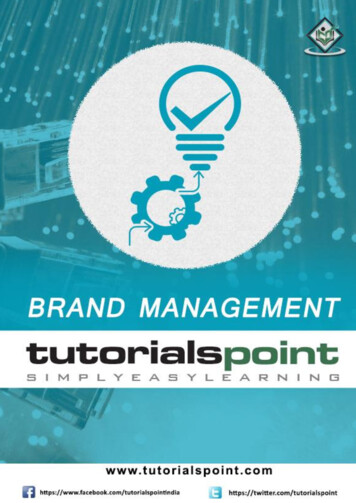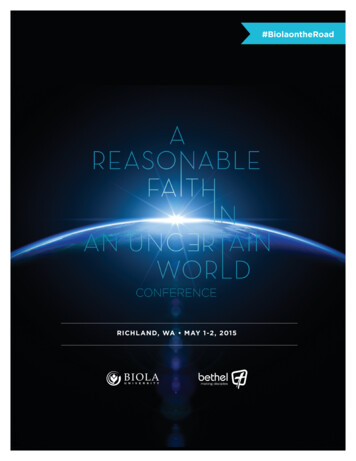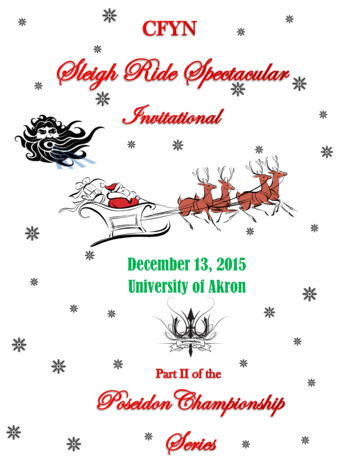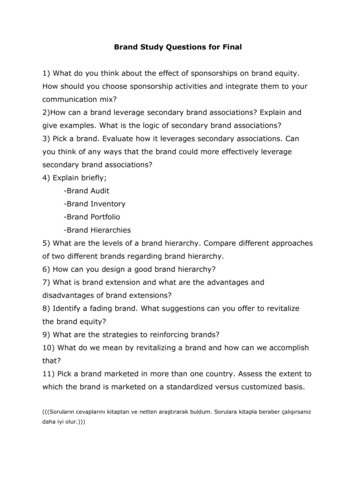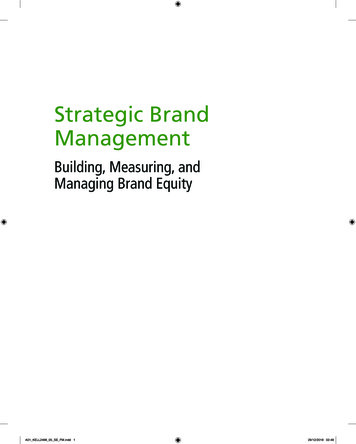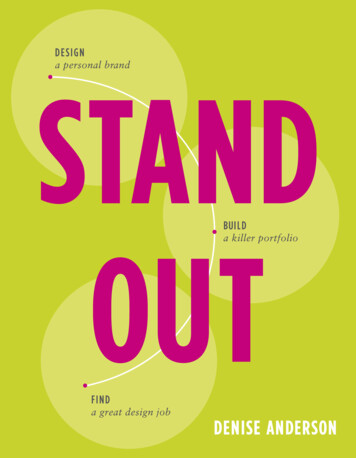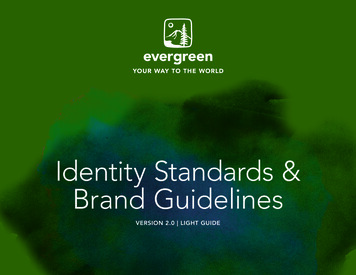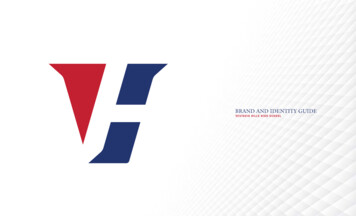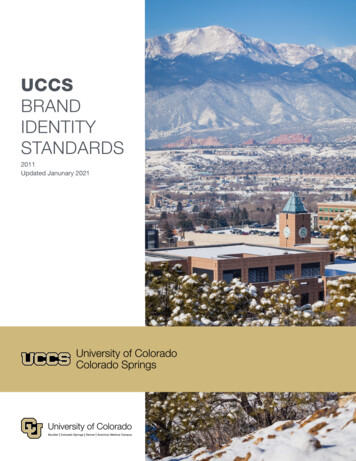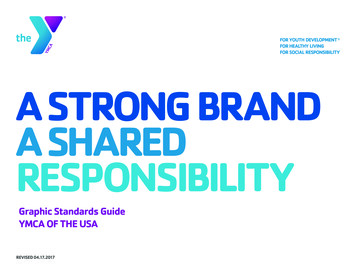
Transcription
A STRONG BRANDA SHAREDRESPONSIBILITYGraphic Standards GuideYMCA OF THE USAREVISED 04.17.2017
TABLE OF CONTENTS3INTRODUCTION15 BENEFIT STATEMENTS4BRAND OVERVIEW17 IMAGERY5ELEMENTS OF OUR IDENTITY18 CREATING YOUR LAYOUT6OUR NAME19 SAMPLE LAYOUT IDEAS7BASIC ELEMENTS OVERVIEW20 PROPER USE OF HISTORICAL LOGOS8ACCEPTABLE LOGO VERSIONS9UNACCEPTABLE USES21 LOCAL YMCA RECOGNITION ONPARTNER COLLATERAL10 CLEAR SPACE AND MINIMUM SIZE12 AREAS OF FOCUS USAGE13 COLOR USAGEY GRAPHIC STANDARDS GUIDE22 DONOR AND SPONSOR RECOGNITION23 PROTECTING OUR BRAND24 CONTACT INFORMATION14 FONT2Benefit Statements used in this resource are provided as examples only. YMCA of the USA discourages actual use of these statements due to potential existing Federal Trademarkprotection status. Use of these benefit statements may subject your YMCA to legal action for trademark infringement.
INTRODUCTIONDEAR COLLEAGUES:The Y brand represents what we stand for, the work we do and our determination to deliver lasting personal andsocial change in the communities around us. Strong branding ensures that the perception of the Y is consistentwith our standing as the leading charitable, nonprofit organization dedicated to strengthening communitythrough youth development, healthy living and social responsibility.We nurture our kids, we open doors to healthy living and we foster a more just and caring society. We are herefor the whole community—everyone is welcome at the Y. Our brand embodies this and everything we are as anorganization.We have policies and protocols in place to promote and protect our brand, and I thank you for following them.But I also hope that you will bear the spirit of our brand in mind. Think nationally (and globally), because that isthe scope of our work, and act locally to uphold our shared reputation and advance our shared goals. This is ourresponsibility to each other.Our brand depends upon all of us working together to present the Y as a unified organization, so we all must be stewards. From the smallest detailto the biggest campaign, all of our communications and interactions shape public understanding of the Y, now and for the future. We are perhaps themost determined, welcoming and hopeful organization in the country. Our brand sends this message clearly and consistently to our communities.Kevin WashingtonChief Executive OfficerYMCA OF THE USA3Y GRAPHIC STANDARDS GUIDE
BRAND OVERVIEWY GRAPHIC STANDARDS GUIDE“To strengthen the foundation of community,” is our brand promise.BRAND PROMISE DEFINEDThe brand promise is our cause. To strengthen the foundations ofcommunity. The brand promise is not a tagline and is not intendedfor marketing collateral. It serves as our inspiration for building astrong, cohesive organization.OUR VALUESOur core values unite us as a Movement. They are the shared beliefs andessential principles that guide our behavior, interactions with each otherand decision-making. Our four values: C aring: Show a sincere concern for others H onesty: Be truthful in what you say and do R espect: Treat others the way you would want to be treated R esponsibility: Be accountable for your promises and actionsAREAS OF FOCUSIn today’s environment, we face increased pressure to demonstrate ourimpact. That’s why we have grouped programs and services into threeareas of focus. This is essential for demonstrating how we deliver onour cause and helps drive an understanding of our organization forour members, donors and volunteers. Similar to our cause, values andvoice, the areas of focus are an essential tool for helping the publicunderstand what we do. F OR YOUTH DEVELOPMENTNurturing the potential of every child and teen. F OR HEALTHY LIVINGImproving the nation’s health and well-being. F OR SOCIAL RESPONSIBILITYGiving back and providing support to our neighbors.OUR VOICEWe use the word “voice” to describe the way our brand looks, soundsand feels. It expresses our personality. The following terms describe thetone of all our communications in person or in writing. D etermined: To devote full strength and concentrated attention toour cause N urturing: To care for, support and help develop throughencouragement G enuine: To be honest and open in relationships with others H opeful: To take an optimistic or positive view of future outcomes W elcoming: To accept neighbors eagerly, warmly, hospitably and asequal participants4BRAND PROMISE CAUSEThe brand promise is our cause. Tostrengthen the foundations of community.The brand promise is not a taglineand is not intended for marketingcollateral. It serves as our inspiration forbuilding a strong, cohesive organization.
ELEMENTS OF OUR IDENTITYELEMENTS OF OUR IDENTITYY GRAPHIC STANDARDS GUIDEOur brand identity uses more than words tobring our cause to life. Its basic elements—logo, areas of focus, color palette, imagery,font and benefit statements—are the buildingblocks for consistently and effectivelycommunicating who we are and our impact.5
OUR NAMEY GRAPHIC STANDARDS GUIDEThe Y R efers to our collective presence and is used when writing about ourcause, our brand promise, our voice, our values or our overall impactas a leading nonprofit. W hen we speak about our brand, our voice, what we stand for, e.g.,the mission of the Y; the Y brand; at the Y, we speak in one voice.YMCA As part of the formal name of locations, associations, branches andcamps. MUST be included on all forms of signage indicating location I n text only, to describe signature programs and events that we wantpeople to immediately associate with the YMCA. F or informal reference to a location once the formal name hasbeen used.The YMCA of Greater Louisville welcomes you.Join the Y.Meet me at the Y.6Participate in the YMCA’s Healthy Kids Day.Ys across the country have a shared look.YMCA of Greater Syracuse members: Renew yourYMCA membership today!Our Y’s facilities are closed for the holiday.The YMCA of Greater Louisville welcomes you.
BASIC ELEMENTS 0VERVIEWY GRAPHIC STANDARDS GUIDEThis section summarizes the basic elements—logo, areas of focus, color palette, imagery, font, benefit statements—in our visual system. Eachelement is designed to work in harmony with the others. When combined, the elements convey the richness of our brand. Each element is furtherexplained on the pages noted below its description.Logo variationpage 14Areas of focuspage 20Color palettepage 18Imagerypage 22Fontpage 23AaBbCcCachet uvwxyz0123456789!@# % &*Cachet stuvwxyz0123456789!@# % &*Cachet uvwxyz0123456789!@# % &*TIME TOEXPLOREJOIN USIN GIVINGBACKTOGETHER WECAN BUILD ABETTER USBenefit statementspage 24BESTSUMMEREVER7FORCOMMUNITY
ACCEPTABLE LOGO VERSIONSY GRAPHIC STANDARDS GUIDEBelow are the only acceptable versions of our logo. Each version has a specific purpose and may not be used in ways other than those listed in thisguide. Logos do not have to be used in a certain order, but make sure to use a variety. Logo color should not be assigned to a location, department, orprogram.The Y has a master brand strategy that mandates the use of a single, stand-alone logo. Additional logos or marks cannot be created. Allother Y program, event, initiative and team logos created and adopted over the years have been retired and may no longer be used. Limited use of threehistoric marks is permitted under certain circumstances. Please refer to the Application of Y Graphic Standards for Historic National Logos found on theBrand Resource Center for guidance on their proper use.FULL-COLOR CMYK/RGBFull-color CMYK/RGBThe full-color version of the logo is the preferred version and, whenever possible,should be used on all branded materials. Use this version of the logo whenCMYK printing is available or RGB is needed for screen viewing. Use the otherrecommended versions below as needed.Note: This version of the logo may only appear on a white background.Do not remove or alter any elements of the logo.2-COLOR PMS: For budgetary reasons there are three other logo options offered.2-color PMSUse the 2-color version when full-color printing is not possible. This version isgood for PANTONE printing, silkscreen, embroidery or items such as golf balls.Note: This version of the logo may only appear on a white background.Do not remove or alter any elements of the logo.KNOCKOUT (white)8(Black)The knockout version is for use on a darkbackground or photograph. When using thisversion you must ensure that the backgroundcolor or photograph is dark enough toprovide contrast for legibility. To maintain atransparent background in Microsoft Officeprograms use the PNG file format of the logo.When applying the logo in one-color applications,such as faxes, newspaper ads or premium items,use the black version on a white background.You may also use the black logo on a lightcolored background, but only when a solid whitebackground is unavailable. The black logo mustalways be solid black, not grayscale.Note: Knockout versions of the logo are notmeant to be contained in boxes. The boxesused in the examples to the left are not apart of the actual artwork but simulatedbackgrounds.Note: The black version of our logo may be usedwhen neither full-color or 2-color printing isavailable.Do not remove or alter any elements of the logo.
UNACCEPTABLE USESY GRAPHIC STANDARDS GUIDEOur logo is only effective when it is used properly. Presenting the logo incorrectly or distorting it in any way is not permitted. Below are only a fewexamples of ways in which the logo may not be used.of AnytownYMCA of ANYTOWNDo not lock-up the Y logo with copy or YMCA name.Do not create new logocolor combinations.Do not remove the registered mark(trademark).Do not add your YMCA name.Do not remove “the.”Do not remove “YMCA.”Do not alter how color is applied.Do not use a full- or 2-color logoon a photo.Do not create in grayscale.outhDo not use “Y” as a stand-alone letteror as part of a word.Do not stretch the logo.Do not rotate the logo.Do not create a lock-up(locking our logo and all of its elements to another logo or word).Do not place a shadow behindor beneath the logo.ofAnytownDo not use a full- or 2-color logoon a colored background.9Do not enclose the logo in any shapeor illustration.Do not add words or phrases.Do not outline.
CLEAR SPACE AND MINIMUM SIZEY GRAPHIC STANDARDS GUIDEWe want our logo to be clear and easily recognized every time we use it.CLEAR SPACEClear space is the space or “breathing room” maintained around ourlogo. Ensuring that our logo is the correct size and free of competingimagery or text gives it maximum impact. It also defines the minimumdistance from the logo to the edge of a printed piece.Clear spaceBlue border is not for design replication.The minimum clear space is equal to the height of the word“the” in the logo. Please note that the blue border around the logorepresents the minimum space required. The more space surroundingthe logo, the better.MINIMUM SIZETo ensure legibility, the logo must always be 0.25” in height or larger.The trademark symbol ( ) is part of our logo and may not be removedexcept for on certain signage. See the Technical Supplement to the YGraphic Standards for Signage for further information.Industry standard for the registered symbol is that it be visually present;complete clarity is not necessary. Clear spaceMinimum size0.25"10
AREAS OF FOCUS USAGEY GRAPHIC STANDARDS GUIDEWhen we present our areas of focus with our logo, we help audiences understand the totality of our organization and explain why they should join,renew, give, volunteer and advocate.VISUAL APPLICATIONSThe areas of focus must always be used on marketing communicationscollateral—including websites—to help the public understand whatwe do. The areas of focus are optional on promotional materials(e.g., water bottles, gym bags, key chains) and are not necessary oninterior or exterior signage.Horizontal relationship (preferred usage)Maintain the minimum requiredclear space. See page 17.AUse the horizontal relationship whenever possible. It is thepreferred relationship between the logo and the areas of focus.FOR YOUTH DEVELOPMENT aligns with the baseline of “the” inthe logo; FOR SOCIAL RESPONSIBILITY aligns with the baseline ofthe logo.Only use the vertical relationship when space does not allow forthe horizontal relationship. When using the vertical relationship,simply place the areas of focus under the logo with the appropriateamount of clear space. The “FOR” in the areas of focus should be leftaligned with the edge of “the” in the logo. The size of the vertical areasof focus should be the same as it is in the horizontal relationship. A andB are the same size just in different positions.The areas of focus should never be broken apart and used independently.For example, ‘FOR YOUTH DEVELOPMENT’ should not be stenciled onthe wall of your child care area. Instead, use the areas of focus graphicsfile that has ‘FOR YOUTH DEVELOPMENT’ bolded.Vertical relationship (for use when space is limited)Maintain the minimum requiredclear space. See page 17.Do not use the areas of focus without the logo. The areas of focusare not a standalone visual element and must always be paired with theY logo.The areas of focus should not be used on strategic relationshipcollateral, but may be used on donor and sponsorship recognitioncollateral. See page 22 for further details.B11
AREAS OF FOCUS USAGE (CON’T)USING THE AREAS OF FOCUS IN COPYThe areas of focus phrases without the word ‘FOR’ (“YOUTHDEVELOPMENT”, “HEALTHY LIVING”, and “SOCIAL RESPONSIBILITY”)may be used independently in copy. Reference the Y Voice MessagingGuide for further guidance on how the areas of focus may be usedwithin messaging.DOWNLOAD AREAS OF FOCUSThe areas of focus graphic files with the trademark symbol must alwaysbe downloaded from the Brand Resource Center and never be typed out.The visuals may not be altered in any way; this includes changingthe color, removing, adding or changing area of focus wording,removing the word ‘FOR’, or removing the registered mark.COLOR COMBINATIONSEach combination pairs the Y logo with a specific color of areas offocus. The areas of focus must match the color of the word ‘the’in the selected Y logo. For example, if the Y logo has a green ‘the’the green areas of focus must be used. Correct combinations areshown to the right. Do not alter these colors for any reason.FILE TYPESBe sure your selected file types match. A full-color logo file mustbe paired with a full-color areas of focus file. The same applies to2-color, black and white files.12Y GRAPHIC STANDARDS GUIDEFull-color2-ColorFor this logo, areas of focusmust be in medium blueFor this logo, areas of focusmust be in light blueFor this logo, areas of focusmust be in medium purpleFor this logo, areas of focusmust be in medium purpleFor this logo, areas of focusmust be in medium redFor this logo, areas of focusmust be in medium redFor this logo, areas of focusmust be in medium orangeFor this logo, areas of focusmust be in light orangeFor this logo, areas of focusmust be in medium greenFor this logo, areas of focusmust be in medium green
COLOR USAGEY GRAPHIC STANDARDS GUIDE4 COLOR LOGOSWe have an official color palette to represent our organization. The use of color helps us express that we are as vibrant as the communities we serve,and it is important to be consistent and use only the colors that we’ve chosen as part of our brand. They are identified below, and can also befound on the Brand resource center at www.theybrand.orgOPEN SPACEOpen Space is the canvas for all of our basic elements such as colorand imagery.Main paletteC39 M100 Y100 K 0R169 G43 B49#a92b31PMS 1807CMAIN PALETTEOur official color palette consists of five color families, each of whichsupports a specific logo variation.EXPLANATION OF COLORCMYK colors are used for professional printing, such as brochures andposters. RGB colors are used for digital applications, such as websites,e-mail and Microsoft Office applications. Hexadecimal colors may alsobe used for websites.C0 M100 Y100 K0C10 M80 Y100 K0R237 G28 B36R221 G88 B40C80 M100 Y0 K0#ed1c24#dd5828R92 G46 B145PMS 485CPMS 173C#5c2e91C0 M65 Y100 K0PMS 268CC0 M80 Y100 K0R244 G121 B32C50 M100 Y0 K0R241 G89 B43#f47920R146 G39 B143#f15922PMS 152C#92278fPMS 166CC0 M35 Y100 K0PMS 2415CR252 G175 B23C20 M100 Y0 K0#fcaf17R198 G22 B141PMS 137C#c6168dPMS 233CPANTONE (PMS) colors are used for 2-color printing, silkscreen andembroidery. When selecting colors for design use analogous colorcombinations. For more information on color application reference theAPPLYING COLOR BEYOND THE LOGO section below.C100 M0 Y0 K0R0 G174 B239#00aeefPMS Process Cyan CC100 M30 Y0 K0R0 G137 B208#0089d0PMS 3005CC100 M65 Y0 K0R0 G96 B175#0060afPMS 661CNote: If you use PMS colors for design, you will need to use thecorresponding 2-color version of the Y logo.GRAY AND BLACKGray and black are used for body text within documents andelectronic media. The logo may appear in black under certaincircumstances, such as when color printing is not available. Graymay not be used for the logo.APPLYING COLOR BEYOND THE LOGOThe logos and areas of focus are designed to reflect two neighboring(neighboring) color families (see page 12). Use the same principle whenapplying color to shapes or text. First, use colors that are groupedtogether in the same color family (for example, light, medium and darkred). Then, if you need to include an additional color family, select afamily next to the initial color family (for example, red orange green orred purple blue, depending on the logo you are using).13C70 M0 Y30 K0R32 G189 B190#20bdbePMS 7472CC95 M0 Y55 K0R1 G164 B144#01a490PMS 3268CC100 M55 Y65 K0R0 G107 B107#006b6bPMS 3298Cgray, black and whiteC 0 M 0 Y 0 K 75R 99 G 100 B 102#636466PMS Cool Gray 11 CC 0 M 0 Y 0 K 100R 35 G 31 B 32#231f20PMS Process Black CC0 M0 Y0 K0R0 G0 B0#0PMS Process White
FONTY GRAPHIC STANDARDS GUIDEThe welcoming and caring feel of our organization is also found in the “form” of our words. Typography is the element that gives our words adistinctive look and feel even before someone reads the text. Handle typography sensitively, using a keen eye to keep the overall layout organizedyet dynamic. Cachet and Verdana are the only two fonts ever to be used for YMCA collateral.XTCURPRIMARY FONT—CACHETXT CURVEDD TE font andTE be used for all internal and external materials. It is aCachet is our primarymustVEsans serif font with an approachable and friendly feel that matches the work we do.TEXTEDCURVEDCURXT alteredCachet font may notTEbeV by shadowing, stretching, and outlining. Cachet font may siton a horizontal, vertical, diagonal and curved plane.CURVEDHorizontalCURVED TEXTDIAGONALTEXTD TEXT CURVEDRVEDiagonal TEXTCURVED TEXTTEXTEDXT CURVTEVerticalVERTICAL TEXTXT CURVEDD TE EXT CUTERVVE RVED TDTEXCUTXTCURCurvedHORIZONTAL TEXTNote: To call out areas of copy, you can use underline, color, case, scale or weight; bold titlesof movies, books and plays; and use quotation marks for titles of articles.CachetPrimary qrstuvwxyz0123456789!@# % qrstuvwxyz0123456789!@# % stuvwxyz0123456789!@# % &*Electronic / system fontVerdanaDownload Cachet Font the Brand Resource klmnopqrstuvwxyz0123456789!@# % qrstuvwxyz0123456789!@# % &*ELECTRONIC / SYSTEM FONT—VERDANAFor instances in which our primary font is not available, or for online applications, use oursecondary font, Verdana. Examples of applications include Microsoft Word, Excel andPowerPoint, websites and nopqrstuvwxyz0123456789!@# % &*Bold stuvwxyz0123456789!@# % &*14
BENEFIT STATEMENTSY GRAPHIC STANDARDS GUIDEExtensive research has shown that while most people say they are familiar with the Y they don’t fully understand what we stand for. Benefitstatements, more commonly known as headlines, are an effective way to convey our message and create greater understanding aboutthe impact the Y makes in communities. Below are examples of how to typeset a benefit statement as well as how to create the desired look andfeel. The following pages provide guidance on proper color application.CONSTRUCTING THE BENEFIT STATEMENTIt is vital that our message be seen. To ensure this happens, all benefitstatements must appear in all-caps.Note: When using programs such as Adobe InDesign or Illustrator,the benefit statement is normally type set in Cachet Bold, with -50character tracking, all headers, subheads and body copy with -25character tracking, set the kerning to “optical.”FONT FAMILYFONT STYLEFONT SIZEKERNINGLEADINGAcceptable usageTOGETHER WECAN BUILD ABETTER USTRACKINGUnacceptable usageTogether wecan build abetter us15
BENEFIT STATEMENTS (CON’T)APPLYING COLOR TO BENEFIT STATEMENTSThe logo itself is a very helpful tool in understanding how to applyour color palette to benefit statements.In the diagram to the right, “the” and the bent bar have the primarycolor applied. “YMCA” and the triangle have the accent color applied. Forlines 1-3 of a benefit statement, apply the primary color family of theaccompanying logo (in this case, purple). For lines 4-5 apply the accentcolor family of the accompanying logo (in this case, red).All descriptor lines use one of the accent colors from the logo.Beyond the cover, color can be applied to areas of copy such assubheads, callouts and intro text. We recommend that one-subjectmatter pieces, such as a program flyer, be kept to one primary andaccent color family. For multiple subject areas, such as a programbrochure, you can use all color families—simply apply them in theappropriate order.Y GRAPHIC STANDARDS GUIDEFull-color (gradient) CMYK/RGBLINE 1LINE 2LINE 3Use theprimary colorsof the logoin any orderLINE 4LINE 5Use theaccent colorsof the logoin any orderDESCRIPTORLINESAll descriptor linesuse ONE of theaccent colorsfrom the logoAccentcolorsLINE 1LINE 2LINE 3LINE 3DESCRIPTOR16Primarycolors
IMAGERYY GRAPHIC STANDARDS GUIDEThe images we choose reflect our enthusiasm and optimism as an organization. Select images of clear, high quality that make you smile or strike apositive emotional chord, and that show the nature of our role in the communities we serve.SILHOUETTESilhouetted imagery visually captures a person(s) or object(s) removedfrom their environment and allows the viewer to focus on a specificmoment, emotion or idea. The back ground can be all white or a colorfrom our color palette.SilhouetteIMAGE WITH A BACKGROUNDImages with a background visually capture people engaged in activitiesor interacting with each other while in context to their environment.Backgrounds should be simple and not distracting. Images with abackground can either be full bleed, to the edge of the page, or becontained in a shape. Shapes with corners need to have a corner radiusminimum of .17 inches.ILLUSTRATIONSelect simple, clean illustrations that visually complement our logo.Use illustrations from the Brand Resource Center or create illustrationsthat align with the brand’s visual identity. Do not tie illustrations to aspecific program or service in such a way that they appear to be usedon an ongoing basis or as a logo. When creating or using illustrationsoutside of those provided on the Brand Resource Center, do not useillustrations that have visual detail, dimension, or outlines. Do not useclip art.Image with a backgroundNote:Images and illustrations are available for download on the BrandResource Center.Illustration17
CREATING YOUR LAYOUTY GRAPHIC STANDARDS GUIDEHere you will see how to combine the basic elements to create a dynamic cover layout. Before you start, select a logo and its correct colorcombination for the area of focus. Make sure to vary the logos selected so colors are not assigned to a certain location, department or program.Strive for variety to show vibrance and diversity in our materials and our communications.1. USE THE Y LOGO WITH THE AREAS OF FOCUS Always use the logo in a size that is impactful. Always use the correct color family for the areas of focusthat are associated with the logo. See page 21 for furtherexplanation about the proper logo and area of focus colorcombinations.1 Preferred placement for the logo is in the top left side of a page. ote: When collateral uses the Y logo and another organization’sNlogo, use of the areas of focus must be determined. This is detailedin the Graphic Standards for Strategic Relationships.22. CREATE A MESSAGE THAT MATTERS The benefit statement should lead with why we do what we dorather than just the name of the program itself see page 15. Forfurther explanation on assigning color to benefit statements seepage 16 .CONNECTING TOCOMMUNITY3 Use Cachet font. If Cachet is not available, use Verdana.3. APPLY SUPPORTING IMAGERY Use silhouetted, image with a background, or illustration. Use photographs that have the same overall color tone as thelogo, areas of focus and benefit statement.4. ADD BRAND ARCHITECTURE Offering category or programs and services (one or the other,not both). See Technical Supplement for Brand Architecture foradditional information. Location name. This must be placed, in all caps, as the final itemin section four. Do not put contact information on the cover ofmulti-page collateral.184Togetherhood YMCA OF ANYTOWN
SAMPLE LAYOUT IDEASY GRAPHIC STANDARDS GUIDEThe basic elements can be used in many ways to meet communications or printing objectives. Below are examples of brochure covers and posters forguidance and inspiration.POwErFUlAdvOCATES FOrCOMMUniTYThe Y’s national impact reportBUILDING CAPACITYIT’S THESUMMER TODISCOVERFEEDYOUR FIREUNLOCKINGPOTENTIAL2014 Executive Conference forSmall and Mid-Size YMCAsFor CEOs and Executive StaffFebruary 19-21, 2014Sheraton Sand Key ResortCLEARWATER BEACH, FLA.OFFERING CATEGORIESLOCATIONEmerging Multicultural Leadership Experience (EMLE)October 28-30, 2015TWIN CITIES, MINNESOTAALWAYSHEREFOR YOUOFFERING CATEGORIES2014 Executive Conference for Small and Mid-Size YMCAs 1For CMYK printing or for viewing online,use the full-color version of the logo.For full bleed images use the knockoutversion of the logo.For solid color backgrounds use theknockout version of the logo.For CMYK printing or for viewing online,use the full-color version of the logo.For CMYK printing or for viewing online,use the full-color version of the logo.EXAMPLE:multiple silhouetted imagesEXAMPLE:full bleed imageEXAMPLE:solid color cover with color illustrationEXAMPLE:text as hero in contrast to a smaller imageEXAMPLE:illustrationYOUR PARTNERTO STRENGTHENCOMMUNITYENSUREA BRIGHTERFUTUREAssociation ResourcesYMCA OF THE USAWE’REHERE FORYOUThese alphabet people letters are providedhere for your convenience but do not use alltogether in your final format.Multiple alphabet people letters should notbe used to spell out words or sentences.Program & ServicesLOCATIONWE’REHERE FORTOGETHERWE CANYOU BUILDAProgram & ServicesLOCATIONAQUATICS SCHEDULELOCATION NAMEMain Pool ScheduleWinter 9:00 amAdult Lap Swim(all lanes)5:00-9:00 amAdult Lap Swim5:00-9:00 amAdult Lap Swim(all lanes)5:00-9:00 amAdult Lap Swim5:00-9:00 amAdult Lap Swim(all lanes)High School SwimTeams beginNovember 169:00 am-NoonAdult Lap(Lanes 5-8)9:00 am-NoonAdult Lap(Lanes 5-8)9:00 am-NoonAdult Lap(Lanes 5-8)9:00 am-NoonAdult Lap(Lanes 5-8)9:00 am-NoonAdult Lap(Lanes 5-8)7:30-8:30 amMasters Swim(Lanes 6,7,8)Pool opens at9:15 amMultiple activities areOften scheduled in thispool at the same time.9:00 am-NoonProgrammingLanes 1-49:00 am-NoonProgrammingLanes 1-49:00 am-NoonProgrammingLanes 1-49:00 am-NoonProgrammingLanes 1-49:00 am-NoonProgrammingLanes 1-49:00-11:00 amLesson Pro9:15 am-1:30 pmLap Swim6 LanesNoon-2:00 pmAdult LapLanes 3-7Noon-2:00 pmAdult LapLanes 3-7Noon-2:00 pmAdult LapLanes 3-7Noon-2:00 pmAdult LapLanes 3-7Noon-2:00 pmAdult LapLanes 3-79:00 am-2:00 pmAdult LapLanes 3,4,5Noon-2:00 pmOpen SwimLanes 1&2Noon-2:00 pmOpen SwimLanes 1&2Noon-2:00 pmOpen SwimLanes 1&2Noon-2:00 pmOpen SwimLanes 1&2Noon-2:00 pmOpen SwimLanes 1&211:00 am-1:00 pmHyde School3 Lanes3:00-5:15 pmSwim Team3:00-7:00 pmSwim Team3:00-5:15 pmSwim Team3:00-7:00 pmSwim Team3:00-5:15 pmSwim TeamSchedule BeginsMonday, November 2and is subject to change[YMCA NAME]ymca.net/give481538 9/157-7:30 amProgrammingSaturdaySunday7-7:30 amProgramming11:00 am-NoonOpen Swim1-2:00pmOpen SwimBETTER USFrom safe spaces to academic achievement tofamily well-being and more, when you donate to the Y,you’re giving those in need the opportunity to thrive.Give for a better us.Annual Campaign7-7:30 amProgramming5:15-6:15 pmHyde School 4L5:15-6:15 pmHyde School 4L5:15-6:15 pmHyde School 4L5:15-7:00 pmAdult Lap 4L5:15-7:00 pmAdult Lap 4L5:15-7:00 pmAdult Lap 4L6:00- 7:00 pmOpen Swim6:00- 7:00 pmOpen Swim2:00-3:00 pmPool Rental6:00- 7:00 pmOpen Swim7:00-8:00 pmMorse High 6L7:00-8:00 pmMorse High 6L7:00-8:00 pmMorse High 6L7:00-8:00 pmMorse High 6L7:00-8:00 pmMorse High 6L7:00-8:00 pmAdult Lap 2L7:00-8:00 pmAdult Lap 2L7:00-8:00 pmAdult Lap 2L7:00-8:00 pmAdult Lap 2L7:00-8:00 pmAdult Lap 2LLap Swimming Tips:Direction:Speed:Please enter the pool from the shallow end. Toavoid accidents, when entering an occupied lane,please get the first swimmer’s acknowledgementthat you are there. Please get kickboards, pullbouys, etc before entering the pool.If there are 1 or 2 swimmers in a lane, they mayelect
CLEAR SPACE AND MINIMUM SIZE Y GRAPHIC STANDARDS GUIDE We want our logo to be clear and easily recognized every time we use it. CLEAR SPACE Clear space is the space or "breathing room" maintained around our logo. Ensuring that our logo is the correct size and free of competing imagery or text gives it maximum impact. It also defines the minimum

